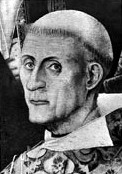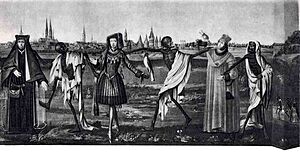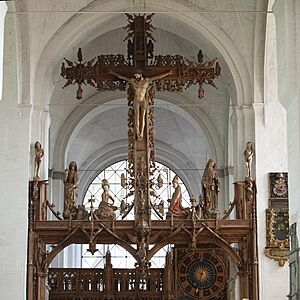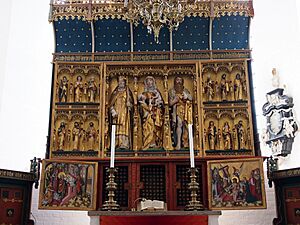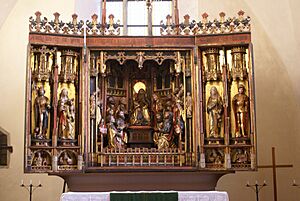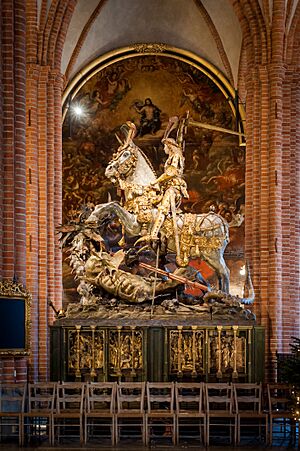Bernt Notke facts for kids
Bernt Notke (born around 1440, died before May 1509) was a very important artist from the late Gothic period. He created amazing artworks in the Baltic region and was known as one of the best artists in northern Europe during his time.
Contents
Bernt Notke's Early Life
We don't know much about Bernt Notke's early life. His family was from Tallinn in Estonia. His father, Michel Notke, was likely a trader and ship owner there. Bernt was born in Lassan, a small town in Pomerania. He was married and had two daughters.
He probably spent some of his younger years in Flanders, where he started learning how to be an artist. He might have worked in a workshop that made large tapestries. This experience likely taught him how to manage big art projects with many people working together.
In the early 1460s, Notke moved to Lübeck, a city in Germany. He lived there for most of his life, but he also spent time in Sweden and often traveled around the Baltic Sea. He was first mentioned in Lübeck city records in 1467. From 1491 to 1497, he lived in Stockholm, Sweden, and even worked as the official mint master for three years. After 1497, he returned to Lübeck and lived there until he passed away in 1509.
Notke's Art and Workshop
How Medieval Art Was Made
Art in the Middle Ages was different from today. Modern artists often work alone, but medieval art was usually made by a team in a workshop. Bernt Notke was the head of one such workshop. When a large cross he made was being repaired, a note was found inside. It was signed by Notke and five co-workers, including a carpenter, a painter, and other skilled workers. This shows that his projects were team efforts.
It's not fully clear if Notke was mainly a painter, a woodworker, or the main organizer. The city council of Lübeck called him a "painter" in 1467. His workshop created many types of art, like tapestries, wooden sculptures, and paintings. They were especially known for making altarpieces, which combine both sculptures and paintings.
Famous Works by Notke
Lübeck Danse Macabre
One of Notke's first known works was a huge tapestry called the Danse Macabre (the Dance of Death). It was about 2 meters (6.5 feet) tall and at least 26 meters (85 feet) long! He made it between 1463 and 1466 for St. Mary's Church in Lübeck. Sadly, it was destroyed during a bombing in 1942. However, a copy made in 1701 still exists.
Tallinn Danse Macabre
Another Danse Macabre was made around the same time. A part of it, about 7 meters (23 feet) long, can still be seen today in St. Nicholas' Church in Tallinn, Estonia. Both of Notke's "Dance of Death" artworks show his unique and lively style.
Lübeck Triumphal Cross
From 1470 to 1478, Notke created a very large sculpture group called a triumphal cross for Lübeck Cathedral. It has 72 sculptures made from oak wood. Experts have confirmed the wood was cut around 1470. This artwork is admired for how realistic, grand, and expressive it is. The bishop Albert Krummedik ordered this impressive piece.
Aarhus Cathedral Altarpiece
In 1479, a huge altarpiece made by Notke's workshop was put in Aarhus Cathedral in Denmark. It was ordered by Bishop Jens Iversen. At 12 meters (39 feet) tall, it was the largest altarpiece in the Nordic countries at that time. It has many sculptures, with three large ones in the middle: Saint Anne, John the Baptist, and Pope Clement I. Bernt Notke signed this altarpiece in three places.
High Altar in Tallinn Church of the Holy Ghost
Notke also made a beautiful altarpiece for the Church of the Holy Ghost in Tallinn, Estonia, finished in 1483. We know it's his because some letters from him asking for payment for the altarpiece have been saved! This altarpiece is smaller, about 3.5 meters (11.5 feet) tall. It's special because its main part shows a Bible scene (the Holy Spirit coming down on the Apostles and Mary) instead of just a line of saints. It's also the only one of Notke's altarpieces that still has its original paint and colors.
Saint George and the Dragon (Stockholm)
Perhaps Notke's most famous sculpture is Saint George and the Dragon in Storkyrkan (the main church) in Stockholm, Sweden. It was unveiled on New Year's Eve in 1489. The Swedish leader Sten Sture the Elder asked Notke to make it to celebrate his victory over King Christian I of Denmark in the 1471 Battle of Brunkeberg. There are copies of this statue in Lübeck and Stockholm. This artwork inspired many other wooden sculptures of Saint George and the Dragon in Sweden, Finland, and Germany.
Other Artworks
Many other unique artworks in Sweden are thought to be from Notke's workshop. These include a sculpture of Charles VIII of Sweden at Gripsholm Castle and an altarpiece in Rytterne Church that shows the Mass of Saint Gregory very realistically. There are also sculptures of Saint Eric in Strängnäs Cathedral and Thomas Becket (now in the Swedish History Museum). An altarpiece in Skellefteå in Sweden is also attributed to him.
Some works that were once thought to be by Notke are now uncertain. Also, some of his works have been lost. For example, the main altarpiece of Uppsala Cathedral was made by Notke but was destroyed in a fire in 1702.
Notke's Artistic Importance
Bernt Notke is known as a very skilled artist. He has been called "one of the most important artists" in northern Europe during the 15th century. Some experts say he was the only artist in northern Germany who could compare to the amazing artists in the south of the country. He is seen as the best example of late Gothic art in the Baltic region.
Many people consider his Saint George and the Dragon in Stockholm and the triumphal cross in Lübeck to be masterpieces of European sculpture. Notke's strong artistic style influenced art throughout the Baltic region. Two of his students are known by name: Heinrich Wylsynck and Henning van der Heide. Henning van der Heide is considered his most talented follower.
Remembering Bernt Notke
A sculpture honoring Bernt Notke stands in the harbor of his hometown, Lassan.
See also
 In Spanish: Bernt Notke para niños
In Spanish: Bernt Notke para niños


